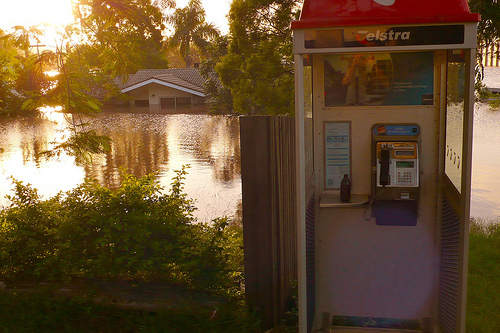Disasters could cut NBN comms: Internode

In the event of a natural disaster, fixed-line and mobile phone customers may be cut off because the National Broadband Network won't build redundancy into its network under proposed points of interconnect, Internode's general manager of regulatory and corporate affairs John Lindsay has warned.

(Brisbane floods image by Martin Howard, CC2.0)
In Internode's submission on the Australian Competition and Consumer Commission (ACCC) and NBN Co's proposal for 120 (now 121) points of interconnect (POIs) where NBN Co's service will end and access seekers will connect customers, Lindsay criticised the number of connection points stating that having so many POIs "will significantly increase the costs of interconnecting with the NBN", and predicted it would lead to smaller providers relying on sub-wholesalers or exiting the industry altogether.
Lindsay also flagged that the high number of POIs prevented NBN Co from building redundancy into its network in the same way it would have if there had only been two points of interconnect in every major city under the 14 POI proposal.
"[Currently] internet services are being provided by many operators without protection in any part of the access network, but most Telstra PSTN voice services are built with significant protection within the network," Lindsay said. "By moving to a large number of POIs the opportunity to build effective protection is lost. In the event of significant natural or unnatural disasters hundreds of thousands of network users will be left without any fixed line service at all."
"What is more, as mobile operators shift their backhaul traffic to the NBN mobile services are likely to be disabled too," he said.
Lindsay later explained to ZDNet Australia that dual capital city POI would allow service providers to connect via two ISP points of presence (POPs) in each capital city. This would mean that in the event that an ISP POP failed or one of NBN Co POIs failed, then the customer would remain connected. Something, Lindsay said would not be possible in a high POI model.
"By dramatically increasing the number of POIs retail service providers NBN Co and retail service providers cannot afford this level of redundancy because 242 NBN POI sites and matching retail service provider connections would be prohibitively expensive," he said, adding that the new 121 POI model would restrict the coverage of each POI.
"While it is certainly possible to build facilities with a very high level of availability it is never the less difficult to operate when your building is surrounded by bush fire or the ground has opened beneath you in an earthquake."
Lindsay said that NBN Co and the ACCC had decided on a high POI model to "appease backbone fibre operators who expect to extract a toll from every retailer who operates in the 40 regional service areas" and would likely lead to many operators only serving city customers due to high operating costs in regional areas.
"I fear that this model will lead to city-based retailers abandoning the bush to Telstra and ploughing the savings back into their city services," he said. "As a result the 'cherry picking' of DSLAM deployments will be perpetuated and subscribers in regional areas will have less choice and pay higher prices."
Lindsay said that Internode was committed to operating over the NBN in regional areas but not at the expense of the company's survival.
Network redundancy has been put to the test in Australia recently. During the cyclone disaster in Queensland last month, a Telstra link to Cairns was cut for a number of hours, and while data was affected, voice services remained in place. In the Queensland floods in January, backhaul service provider NextGen lost connectivity on its Brisbane to Sydney link after its primary and secondary cables were damaged.
Voice, data and mobile services for the three major carriers Telstra, Optus and Vodafone were also hit hard in the affected areas in Queensland by the floods and Tropical Cyclone Yasi.